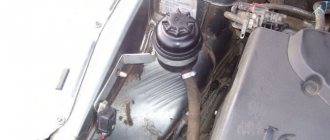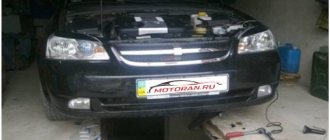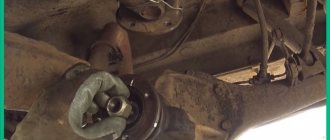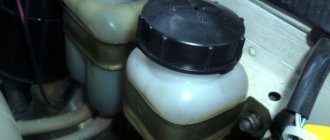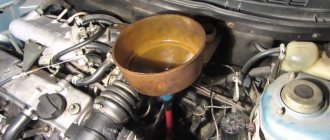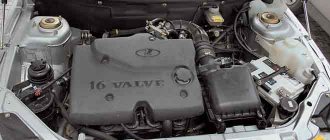Successful change of power steering oil WITH YOUR HANDS ON A Chevrolet Lacetti
Do not be alarmed if at first you hear noise in the area of the power steering pump, this is normal; when the liquid fills the entire system, it will disappear.
How to change the oil in the power steering of a Chevrolet Lacetti. We substitute the same container for the “return” and produce...
Therefore, it is necessary to use a replacement fluid with the same characteristics. I decided to correct this misunderstanding.
And the fact is that this liquid, according to my subjective feelings, is an order of magnitude superior to the one I poured in earlier. And this, in turn, will cause a hum and noise when turning the steering wheel, so be careful.
Having reached the bottom, we find that the syringe no longer takes the liquid, but it remains in the tank: We place the container under the first pipe that goes to the pump and throw it off, thereby allowing the liquid to flow out.
After that, we put the pipe back on and remove the return line.
This is necessary to expel any remaining liquid in the system. That’s why we hung the wheels, to make it easier to turn the wheels, because the engine is turned off and if you start it, the pump can catch air, which is fraught. In general, we place a container under the hose and turn the steering wheel left and right until it stops and back.
Replacing fluid in the power steering of a Chevrolet Lacetti: video
The hydraulic power steering on the Chevrolet Lacetti is not much different from similar devices on other cars.
More information about power steering fluid on a Chevrolet Lacetti
While operating the vehicle, periodically check the level in the power steering reservoir. There is no sensor on the tank lid.
The manufacturer does not say anything about replacing the power steering fluid, but, as practice shows, replacement is sometimes necessary every 55–60 thousand mileage.
What, how and when?
For a partial replacement, 1 liter should be enough.
- The system is filled with either branded GM Dexron III fluid or any analogue from third-party manufacturers.
- System volume is about 1.1 liters.
When and how to change the oil in the power steering system, we will consider all the subtleties of the process and the operating procedure together today.
Signs for replacement
Has the liquid in the reservoir turned dark brown and lost its consistency? So it needs to be changed!
A sign of a faulty power steering is an increased noise level in the mechanism while driving, as well as increased force on the steering wheel.
The fluid does not last forever and the driver himself can accelerate its wear. If you hold the steering wheel in extreme positions for a long time and often, turn the wheels sharply and forcefully and do not monitor the oil level in the tank, over time it oxidizes, overheats, and a pronounced burning smell appears, then such oil requires prompt replacement.
Otherwise, the amplifier mechanism and pump parts may very soon die out.
As we said, the plant does not standardize the mileage between power steering fluid changes, so you only need to focus on the condition of the fluid and the steering mechanism. If the liquid has acquired a dark color, we buy a new one, change it and bleed the system.
We partially change the fluid
Replacing the fluid in the system can be done using two methods - you can replace the fluid 100%, or partially. Depending on the state of the system, one or the other method may be useful. But first, let’s perform an express diagnostic of the system:
- We control the oil level and its condition in the tank.
- Check the tension of the power steering pump drive belt.
- We inspect the hoses for cracks and abrasions.
- We look at the places where the hoses are fixed; there may be leaks there. We eliminate malfunctions if there are any.
To partially replace the fluid, we will need a syringe with a tube for sampling from the tank and about a liter of oil. The process goes like this:
- Remove the lid from the tank.
- We pump out the oil from there using a syringe and tube. The liquid was pumped out.
- Fill with fresh liquid to the maximum level. Filled at the top line.
- We start the engine and turn the steering wheel from one extreme position to the other, while monitoring the oil level. We turn off the engine. Everything is simple here. We turned the steering wheel and turned off the engine.
- Pump out the oil again and add fresh oil.
- We continue this cycle until the oil in the tank becomes lighter in color.
This method does not guarantee a complete replacement, nor does it guarantee complete bleeding of the system, so it is used in rare cases.
Complete independent oil change in the power steering on a Chevrolet Lacetti
Now let's get ready to completely replace the fluid in the system and pump it. For this you will need a lift or two jacks. The idea is to have the two front wheels hanging out at the same time. After this you can start replacing:
- Open the reservoir cap and pump out all the oil. Power steering reservoir cap without cap.
- Two hoses are connected to the tank - one in front, the second in back. The front hose connects the reservoir to the power steering pump, the rear hose connects the return line. Remove the front hose and lower it into a container; the liquid should drain completely. Using a syringe, pump out the liquid from the tank.
- Remove the rear return hose and place a container under it. The hoses were removed.
- We turn the steering wheel from one extreme position to another, pausing a little at the extreme points. We do this until the oil stops flowing. To remove oil more completely, you can blow into the front hose, creating a slight pressure in the system.
- We connect the hoses to the tank and fill it with fresh fluid.
- We turn the steering wheel from the far right to the far left until the liquid begins to leave the tank. We do not start the engine.
- As soon as the level begins to drop, add oil to the maximum. New fluid in the power steering reservoir.
- We start the engine, rock the steering wheel evenly, without stopping at the extreme points. With the engine running, check the oil level and, if necessary, add until the level stabilizes while the engine is running.
After replacement, after 100–200 km, we check the fluid level and the tightness of the hose connections. Good luck to everyone and enjoy your travels!
Video about completely replacing power steering fluid on a Chevrolet Lacetti
Changing the power steering fluid of a Chevrolet Lacetti
any regulatory standards for replacing fluid in the Chevrolet Lacetti power steering .
However, if you find that the color of the fluid in the power steering reservoir has changed and it has become dark, this is a sign that there is a malfunction in the power steering system and it needs to be repaired.
After performing a particular power steering, completely replace the fluid.
What kind of fluid should be poured into the power steering of a Chevrolet Lacetti
Initially, power steering Sherol Lacetti uses Dexron II D or Dexron III , therefore it is recommended to replace fluid with the same characteristics. Based on this, we purchase either original GM Dexron III (II D) oil or analogues from other manufacturers (SAE 75W-80, API GL-3/GL-4, Ford Mercon, Allison C4)
Examples of fluids for possible use in the Chevrolet Lacetti power steering
Changing the power steering fluid of a Chevrolet Lacetti
Instructions for replacing power steering fluid
- To freely turn the front wheels, we hang the front of the car
- Open the lid of the power steering reservoir and use a large medical syringe to pump out all the liquid from it.
- Then we find two hoses under the tank. We disconnect the first one, which goes to the power steering pump, and place a previously prepared container (plastic bottle) under it and wait until the liquid stops leaking. After this, we put the hose back on the fitting in the tank.
- Now we will be interested in another hose - the “return” hose, which will also need to be removed. In the photo you can see which of the hoses will be the return hose.
Changing the power steering fluid of a Chevrolet Lacetti
- We substitute the same container under the “return” and pump out the remaining fluid into the power steering of the Chevrolet Lacetti. To pump out all the old fluid from the system as much as possible, you need to turn the steering wheel all the way, first in one direction and then in the other, while making short pauses in extreme positions. This operation must be performed until the liquid stops leaking.
- After this, connect the hose back to the tank and fill it with new fluid. Without starting the engine!!! Again, slowly turn the steering wheel several times in different directions, with a slight delay in the extreme position. Be sure to make sure that the liquid in the tank does not fall below the level and top up if necessary. We carry out this operation until the liquid stops decreasing.
- Now you can start the engine. Do not be alarmed if at first you hear noise in the area of the power steering pump, this is normal, as soon as the liquid fills the entire system, it will disappear. With the engine running, repeat turning the steering wheel left and right, but without pauses and not all the way. We check the level and, if necessary, add fluid until it is at the MAX mark when the engine is running.
Required Tools
In order to replace the working fluid of the Chevrolet Lacetti power steering circuit, you will need the tools listed in the table below.
Table - List of tools that will be needed when changing power steering oil on a Chevrolet Lacetti
| Name | Note |
| Jack | 2 pcs. For hanging the front of the car. When lifting the car on a lift, there is no need for jacks. If you don't have a second jack, you can use supports. |
| Syringe | More than 10 cm 3 |
| Hose | For more comfortable drainage of liquid. |
| Key | "on 10" |
Choosing oil for filling in power steering Chevrolet Lacetti
The original power steering fluid is GM Dexron VI. This oil is filled from the factory. General Motors products have article number 1940184. Its price starts from 650 rubles. By purchasing the original fluid, the car owner receives a number of advantages:
- temperature stability;
- low kinematic viscosity;
- freezing at -60° C, which prevents defrosting of the power steering circuit in winter;
- preservation of properties during long-term use;
- oxidation resistance;
- low foaming;
- presence of extreme pressure additives;
- good anti-corrosion properties;
- does not require flushing the system when filling;
- compatible with the materials from which power steering elements in contact with oil are made.
When switching to power steering fluid from a third-party manufacturer, simply adding and mixing oils is prohibited. Therefore, before filling in the newly acquired liquid, it is necessary to flush the circuit. The best options for alternative oils are shown in the table below.
Table - List of analogues of the original Chevrolet Lacetti power steering fluid
BrandApproximate cost ruble
| LUKOIL ATF SYNTH VI | 310 |
| MANNOL ATF Dexron VI | 400 |
| ZIC ATF | 210 |
| KROON OIL SP Matic | 480 |
| TOTAL FLUIDMATIC MV LV | 470 |
Fluid replacement Gur Cruz 1.6
Choosing which oil is better to fill in the power steering for a Chevrolet Cruze
When checking the fluid in the power steering reservoir on a Chevrolet Cruze , from time to time you can see that there is less water than it should be. Chevrolet cruze station wagon 1.8 mt ltz black › logbook › replacing brake discs are on the Cruze 1.4, 1.6 and 1.8.
Replacing the power steering fluid, replacing the power steering pump pulley and belt. Despite all this, there are no leaks and the hydraulic booster is operating normally. This article discusses power steering oil in a Chevrolet Cruze, choosing power steering fluid, required tools, and replacing power steering fluid.
After all, if the Ford Focus 2 power steering oil is replacing the power steering fluid. In fact, the prerequisite for this may be worn out or incorrectly selected power steering fluid. Replacing the timing belt on a Chevrolet Cruze 1 6 with your own hands. Instructions for changing the power steering fluid for the Chevrolet Lacetti and Cruz. Replacing power steering fluid.
Let’s figure out together what kind of oil to fill into the Chevrolet Cruze power steering and how to choose it correctly.
What kind of oil is poured into the power steering on a Chevrolet Cruze
Dexron VI only.
For those who are too lazy to read further, let's say right away that the Chevrolet Cruze , regardless of the type of engine, is filled with only transmission oils indicated on the label as Dexron VI . With all this, the company that produced the fluid actually does not matter.
GM Dexron VI branded liter packaging can contain liquid from a variety of manufacturers, so if there is a standard name on the label, you can even save a little.
Why Dexron VI?
Chevrolet Cruze power steering oil change
Subscribe to the channel dedicated to cars and repairs: .
Changing Power Steering Oil
to replace without hassle
power
steering oil . All videos on the page.
Since 2006 only Dexron VI!
General Motors has completely switched to Dexron VI fluids since 2006, replacing Dexron III oils, and there are several reasons for this.
Many manufacturing companies still sell both the third Dexron and Dexron IID, IIE, but they cannot be used in power steering Chevrolet Cruze , since the General Motors concern no longer guarantees the quality of old fluids, especially from third-party manufacturers .
Features of power steering fluid
In the process of completely changing the oil in the power steering.
The new, sixth Dexron has a number of features, without which the Cruise power steering will quickly wear out or not work correctly:
Troubleshooting common problems
If during operation of the Chevrolet Lacetti a problem is detected with the power steering, then repairs can be performed using the algorithm below.
- The first step is to check the power steering fluid level. If it is below or close to the minimum, then add oil. In many cases this helps solve the problem.
- After a certain period after adding fluid, its level should be checked. A significant decrease in it indicates depressurization of the circuit. Troubleshooting must begin with a visual inspection. Troubleshooting depends on the failed unit, but in most cases requires replacing parts.
- If adding working fluid does not restore normal operation of the power steering, then it is necessary to check the pump. Troubleshooting is most conveniently done by ear. When the power plant is running, there should be no extraneous noise from the pump in the form of hum, whistle, squeak, or crackling. The pump has low maintainability, so in most cases it must be replaced with a new one.
Power steering Lacetti. Device
The Lacetti power steering system is quite reliable, but it has one drawback - on most cars, after a certain mileage, a rustling or slight howl begins in the operation of the power steering. Also, do not hold the steering wheel in extreme positions for a long time to avoid increased wear of power steering parts.
Power steering Chevrolet Lacetti
1 — power steering pump; 2 - discharge line; 3 - filling line; 4 — power steering reservoir; 5 - drain line; 6 — steering wheel; 7 — steering column; 8 — intermediate steering shaft; 9 — intermediate shaft seal; 10 — hinge boot; 11 — steering mechanism; 12 — steering gear cover; 13 — left tie rod; 14 — right steering rod
Search
The power steering on the Chevrolet Lacetti is quite reliable, not demanding and attracts attention relatively periodically. Well, it doesn't need much attention - just watch the water level in the tank and see how the device works while driving. But from time to time you need to know what kind of oil to pour into the Lacetti power steering, whether you can combine fluids of different brands and classes. In principle, everything is very simple - General Motors Korea always keeps up with the times and updates its water class.
For example, by 2009, 1100 ml was poured into the power steering. GM Dexron II, following the introduction of the Dexron III, IV and Dexron IIE standard. But these are just names.
Here is the water specification for the various compliance standards:
As follows, the native fluid can be replaced with any appropriate standard, and GM specifically recommends Dexron.
We will not argue with them, say, pour premium oil, for example. Dexron VI, this makes no sense since it was created in 2005 specifically for the HydraMatic 6L80 automatic transmission.
The main difference between Dexron 6 and Dexron 3 is the change in kinematic viscosity. The least viscous Dexron 6 oil allows you to reduce the coefficient of friction in an automatic transmission, but in a hydraulic booster this indicator is not the most important. At least if the package says DEXRON power steering, it can be safely used to refill the power steering system on the Lacetti. An analogue of this oil is Mobil ATF320, or at least some oil that has the UGMS approval mark.
We will not theorize, but we will immediately put ourselves in the shoes of the Lacetti driver, who saw that the water level in the tank was lower than necessary. If there are no leaks or obvious problems with the amplifier, and the fluid is still more or less fresh, in other words, it makes sense to add it. At the top there is usually a brand Jiemovsky DEXRON power steering III. If we are sure that it is specially poured into the system. However, the composition of this oil differs from the industrial spindle, which at each machine-building plant was filled only with a set of additives, and the cost is not dictated by the proletarian origin of the oil.
The color of the water is reddish at first, but it can change greatly over time. This will tell you it's time to change the oil. However, the manufacturer says that the oil is filled for the entire life of the car, although experienced Lackett owners change the fluid every 50-60 thousand km.
Replacing power steering fluid. Gentra / Lacetti
Water discoloration of the steering wheel indicates that it is time to replace it.
The same DEXRON power steering. Regardless of the index, almost all Chevrolet, cheap Toyota and Opel are in power steering. If we decide to completely change the fluid, we will definitely wash the system before filling - You can mix water with various additives that can cause foaming or precipitation. This will certainly affect the stability of the power steering.
Mix, add and change power steering oil for Lacetti
We will not theorize, but will immediately put ourselves in the place of the Lacetti driver, who noticed that the fluid level in the tank is lower than necessary. If there are no leaks or obvious problems with the amplifier, and the liquid is still more or less fresh, then it makes sense to just top it up. As a rule, they top up with Jimmy's proprietary DEXRON Power Steering Fluid III. If we are sure that it is he who is in the system. Frankly speaking, the composition of this oil differs from the industrial spindle that is piled up at every machine plant, only in a set of additives, and the price is not dictated by the proletarian origin of the oil.
The color of the liquid is initially red, but over time it can change greatly. This will indicate that it is time to change the oil. Nevertheless, the manufacturer insists that the oil is filled for the entire service life of the car, although experienced Lacetti owners change the fluid every 50–60 thousand km.
A change in the color of the power steering fluid indicates that it is time to change it.
The same DEXRON Power Steering Fluid, regardless of the index, is poured into the power steering of almost all Chevrolets, inexpensive Toyotas and Opels. If we decide to change the fluid completely, then we will definitely flush the system before filling - there is a possibility of mixing the fluids with different additives, which can cause foaming or sedimentation. This will definitely affect the stability of the power steering.
Replacement
- We hang the front wheels of the car - later we will rotate the steering wheel from right to left to pump the power steering system
- It is necessary to pump out all the fluid from the power steering reservoir using a syringe
- We remove the return hose from the power steering reservoir (the hose that is closer to the car interior) and lower it into some container, since power steering fluid will still flow out from there
- We sit in the cabin and turn the steering wheel left to right (from lock to lock) at least 10 times. We DO NOT start the engine!
- Let's see how much fluid has flowed out of the return hose of the power steering system. After this, we rotate the steering wheel 5 more times from lock to lock and again check how much fluid has flowed out. If the level has increased significantly, then you can repeat the procedure by rotating the steering wheel; if the level has remained virtually unchanged, then this is enough.
- It is advisable to remove the power steering system reservoir and the reservoir cap from the Lacetti and rinse it of old fluid
- Reconnect the system return clamp to the tank and fill the tank with new oil to the MAX level.
- We turn the steering wheel from side to side again, DO NOT start the engine and monitor the fluid level in the tank. Don't let it drop below the MIN mark
- Add oil as needed
- When the oil stops decreasing from the reservoir (the power steering system is almost full), you can start the engine and turn the steering wheel again from lock to lock until the fluid stops decreasing from the power steering system reservoir
The power steering is one of the main components of the steering mechanism. It reduces the force required to apply the steering wheel to make a turn.
Read more: Trunk size of Lada Priora station wagon
This increases the comfort of driving the car, reduces driver fatigue and increases the safety of the car.
For normal operation of the power steering, it is necessary to timely change the oil and use a fluid that meets all the recommendations of the automaker.
Power steering oil change intervals
General Motors does not standardize the mileage or time interval when you need to change your power steering fluid. Car owners are advised to check the oil level every 10-20 thousand km. Fluid replacement is necessary after 60-100 thousand km. When determining the need to fill in new fluid, it is more correct to focus on the following reasons:
- the appearance of extraneous sounds during turns;
- significant change in liquid color;
- burning smell that comes from opening the power steering reservoir;
- heterogeneity of the working fluid;
- jamming when turning the steering wheel;
- the appearance of deposits on the walls of the tank.
Sources
- https://GrandFart.ru/motor/zamena-zhidkosti-gura-lachetti.html
- https://minitraktor34.ru/tehservis/zamena-zhidkosti-gur-lachetti-2.html
- https://autogearspb.ru/zapchasti/kak-pomenyat-zhidkost-gidrousilitelya-rulya-shevrole-lachetti.html
- https://zapchasti.expert/chevrolet/lacetti/gur-maslo-v-gur.html
[collapse]

